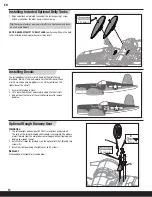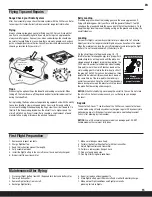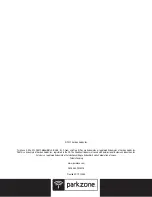
EN
Always
decrease throttle at
propeller strike.
Range Check your Radio System
After final assembly, range check the radio system with the F4U Corsair. Refer
to your specific transmitter instruction manual for range test information.
Flying
Always choose a wide-open space for flying your F4U Corsair. It is ideal that
you fly at a sanctioned flying field. If you are not flying at an approved site,
always avoid flying near houses, trees, wires and buildings. You should also
be careful to avoid flying in areas where there are many people, such as busy
parks, schoolyards or soccer fields. Consult local laws and ordinances before
choosing a location to fly your aircraft.
Flaps
When using the optional flaps, the takeoffs and landings are shorter. When
taking off, the tail will come off the ground quicker for better rudder control
during the takeoff roll.
During landing, the flaps allow a steeper landing approach and with the ability
to use less throttle. A slower airspeed makes it easier to flare and settle in
for a smooth landing. When deploying the flaps, slow the aircraft down to 1/4
throttle. If the flaps are deployed when the aircraft is at a higher speed, the
aircraft will pitch up. If your transmitter is capable, a slight amount of down
elevator to flap mixing will reduce the pitch up tendency.
Belly Landing
If landing on grass without the landing gear, use the same approach as if
flying with landing gear. Start your flare with the power off about 1 foot (30
cm) above the ground and hold the nose up until the tail touches down. Try to
keep the wings level to prevent clipping a wing on the ground and turning the
aircraft sideways.
Landing
For your first flights, set your transmitter timer or a stopwatch to 7 minutes.
Adjust your timer for longer or shorter flights once you have flown the model.
When the motor pulses, land the aircraft immediately and recharge the flight
battery. It is not recommended to fly the battery to LVC.
Fly the aircraft down to the ground using 1/4–1/3
throttle to allow for enough energy for a proper flare.
Avoid sharp turns on the ground until the plane has
slowed enough to prevent scraping the wingtips. The
F4U Corsair is easiest to land doing a wheel landing
(two point), where the aircraft touches down on the
main landing gear first while the tailwheel is still off
the ground. The F4U Corsair can be landed in a three-
point attitude, where all three wheels touch down at
the same time, but the two-point wheel landing is
easier to accomplish. Once the aircraft touches down,
reduce back pressure on the elevator stick to prevent
the plane from becoming airborne again.
NOTICE:
When finished flying, never keep the aircraft in the sun. Do not store
the aircraft in a hot, enclosed area such as a car. Doing so can damage
the foam.
Repairs
Thanks to the Z-Foam™ construction of the F4U Corsair, repairs to the foam
can be made using virtually any adhesive (hot glue, regular CA (cyanoacrylate
adhesive), epoxy, etc). When parts are not repairable, see the Replacement
Parts List for ordering by item number.
NOTICE:
Use of CA accelerant on your model can damage paint. DO NOT
handle model until accelerant fully dries.
1. Remove and inspect contents.
2. Charge flight battery.
3. Read this instruction manual thoroughly.
4. Fully assemble model.
5. Install the flight battery in the aircraft (once it has been fully charged).
6. Bind aircraft to your transmitter.
7. Make sure linkages move freely.
8. Perform the Control Direction Test with the transmitter.
9. Adjust flight controls and transmitter.
10. Perform a radio system Range Check.
11. Find a safe and open area.
12. Plan flight for flying field conditions.
1. Disconnect flight battery from ESC (Required for Safety and battery life).
2. Power off transmitter.
3. Remove flight battery from aircraft.
4. Recharge flight battery.
5. Repair or replace all damaged parts.
6. Store flight battery apart from aircraft and monitor the battery charge.
7. Make note of flight conditions and flight plan results,
planning for future flights.
Fly in this area
(upwind of pilot)
Stand here
600
feet (182.8
m)
Flying Tips and Repairs
First Flight Preparation
Maintenance After Flying
15






































